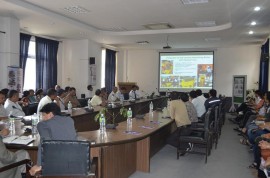
One of the looming challenges in post-earthquake Nepal is the reconstruction of the estimated 600,000 homes that were destroyed. The Asian Institute of Technology (AIT) aims to help rebuild the homes in affected areas Nepal in a quick, cost-effective, and efficient manner.
In July, a team of experts from AIT visited the Department of Urban Development and Building Construction (DUDBC) office in Kathmandu, Nepal to present and discuss the strength, safety, and earthquake resiliency of AIT’s Habitech Building System to several stakeholders.
The technical presentations were delivered by Dr. Naveed Anwar, Executive Director, AIT Consulting and Mr. Gyanendra Sthapit, Director, Habitech Center, AIT . The talks focused on the Earthquake Resilience of the Habitech technology and why it is the best solution to use in an earthquake prone country like Nepal. Known for its low-cost, disaster-resilient technology, and sustainable interlocking component, AIT’s Habitech Center has created a manual mold for making cement soil stabilized blocks by hand. Interlocking bricks can be made at the building site itself by mixing locally available clay with 15 percent cement and does not need to be fired. The walls are reinforced horizontally and vertically, especially at the joints. A typical three-room house can be built in two weeks because the bricks self-align, and cost up to 40 percent less than a conventional brick-cement house.
The participants represented Ministry of Urban Development, National Planning Commission, Department of Urban Development and Building Construction and others. DUDBC is committed to work in direction of safe, economical and environmentally friendly building construction, affordable housing, and sustainable urban development.

